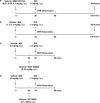An ontogenic study of receptor mechanisms by which acute administration of low-doses of methamphetamine suppresses DOI-induced 5-HT2A-receptor mediated head-twitch response in mice
- PMID: 34983399
- PMCID: PMC8725525
- DOI: 10.1186/s12868-021-00686-5
An ontogenic study of receptor mechanisms by which acute administration of low-doses of methamphetamine suppresses DOI-induced 5-HT2A-receptor mediated head-twitch response in mice
Abstract
Background: Methamphetamine (MA) is a non-selective monoamine releaser and thus releases serotonin (5-HT), norepinephrine (NE) and dopamine (DA) from corresponding nerve terminals into synapses. DOI ((±)-2, 5-dimethoxy-4-iodoamphetamine) is a direct-acting serotonergic 5-HT2A/C receptor agonist and induces the head-twitch response (HTR) via stimulation of 5-HT2A receptor in mice. While more selective serotonin releasers such as d-fenfluramine evoke the HTR, monoamine reuptake blockers (e.g., cocaine) suppress the DOI-evoked HTR via indirect stimulation of serotonergic 5-HT1A- and adrenergic ɑ2-receptors. Since the induction of HTR by DOI is age-dependent, we investigated whether: (1) during development MA can evoke the HTR by itself, and (2) acute pretreatment with either the selective 5-HT2A receptor antagonist EMD 281014 or low-doses of MA can: (i) modulate the DOI-induced HTR in mice across postnatal days 20, 30 and 60, and (ii) alter the DOI-induced c-fos expression in mice prefrontal cortex (PFC). To further explore the possible modulatory effect of MA on DOI-induced HTR, we investigated whether blockade of inhibitory serotonergic 5-HT1A- or adrenergic ɑ2-receptors by corresponding selective antagonists (WAY 100635 or RS 79948, respectively), can prevent the effect of MA on DOI-induced HTR during aging.
Results: Although neither EMD 281014 nor MA by themselves could evoke the HTR, acute pretreatment with either EMD 281014 (0.01, 0.05 and 0.1 mg/kg, i.p.) or MA (1, 2.5, 5 mg/kg, i.p.), dose-dependently suppressed the DOI-induced HTR across ages. While WAY 100635 significantly reversed the inhibitory effect of MA in 20- and 30-day old mice, RS 79948 failed to significantly counter MA's inhibitory effect. Moreover, DOI significantly increased c-fos expressions in several PFC regions. EMD 281014 prevented the DOI-induced increases in c-fos expression. Despite the inhibitory effect of MA on DOI-induced HTR, MA alone or in combination with DOI, significantly increased c-fos expression in several regions of the PFC.
Conclusion: The suppressive effect of MA on the DOI-evoked HTR appears to be mainly due to functional interactions between the HTR-inducing 5-HT2A receptor and the inhibitory 5-HT1A receptor. The MA-induced increase in c-fos expression in different PFC regions may be due to MA-evoked increases in synaptic concentrations of 5-HT, NE and/or DA.
Keywords: 5-HT1A receptor; 5-HT2A receptor; DOI; Head-twitch response; Methamphetamine; ɑ2-adrenergic receptor.
© 2021. The Author(s).
Conflict of interest statement
The author(s) declare no potential conflicts of interest with respect to the research, authorship, and/or publication of this article.
Figures








Similar articles
-
Effects of low-doses of methamphetamine on d-fenfluramine-induced head-twitch response (HTR) in mice during ageing and c-fos expression in the prefrontal cortex.BMC Neurosci. 2023 Jan 11;24(1):2. doi: 10.1186/s12868-022-00766-0. BMC Neurosci. 2023. PMID: 36631757 Free PMC article.
-
Ultra-low doses of methamphetamine suppress 5-hydroxytryptophan-induced head-twitch response in mice during aging.Behav Pharmacol. 2024 Oct 1;35(7):367-377. doi: 10.1097/FBP.0000000000000789. Epub 2024 Aug 5. Behav Pharmacol. 2024. PMID: 39206775
-
The mechanism by which the selective 5-HT1A receptor antagonist S-(-) UH 301 produces head-twitches in mice.Pharmacol Biochem Behav. 1996 Sep;55(1):1-10. doi: 10.1016/0091-3057(96)00072-x. Pharmacol Biochem Behav. 1996. PMID: 8870031
-
The stimulatory and inhibitory components of cocaine's actions on the 5-HTP-induced 5-HT2A receptor response.Pharmacol Biochem Behav. 1996 Nov;55(3):387-96. doi: 10.1016/s0091-3057(96)00108-6. Pharmacol Biochem Behav. 1996. PMID: 8951980
-
Role of the inhibitory adrenergic alpha 2 and serotonergic 5-HT1A components of cocaine's actions on the DOI-induced head-twitch response in 5-HT2-receptor supersensitive mice.Pharmacol Biochem Behav. 1993 Jun;45(2):269-74. doi: 10.1016/0091-3057(93)90238-o. Pharmacol Biochem Behav. 1993. PMID: 8392199
Cited by
-
Effects of low-doses of methamphetamine on d-fenfluramine-induced head-twitch response (HTR) in mice during ageing and c-fos expression in the prefrontal cortex.BMC Neurosci. 2023 Jan 11;24(1):2. doi: 10.1186/s12868-022-00766-0. BMC Neurosci. 2023. PMID: 36631757 Free PMC article.
References
-
- World Drug Report. Stimulants. The United Nations Office on Drugs and Crime (UNODC). Sales No. E.19.XI.8. United Nations publication.
-
- Cruickshank CC, Dyer KR. A review of the clinical pharmacology of methamphetamine. Addiction. 2009;1047:1085–1099. - PubMed
Publication types
MeSH terms
Substances
LinkOut - more resources
Full Text Sources
Medical
Miscellaneous

